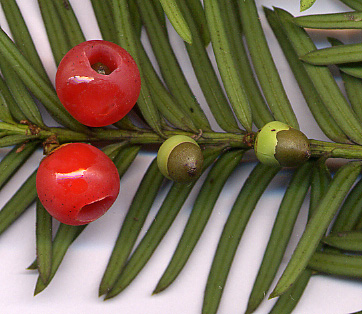Reproduction

As stated in the classification page, the English yew is a gymnosperm, meaning that it reproduces like other conifers with seeds contained in cones. In order to produce a mature cone, pollen from a male tree must pollinate a female tree for the production of the seed. This pollination between trees is heavily dependent on wind to carry the pollen.
Once pollinated, the cone forms the seed. Upon maturity, a bright red structure, specific to yews, called an aril forms. While it may not look the part, this structure is nothing more than a highly modified cone.
In the picture to the right, you can see the immature seed start to form in the center of the the cone. In the mature aril to the left of the immature cone, you can see one of the seeds in the center of the aril. The aril is the only part of the yew tree that is not poisonous, which is advantageous because birds will eat them and spread the seeds to other areas.
Reproductive success of the English yew is very low, which makes conservation efforts very difficult. The trees also take a long time to mature, compared to other trees. Habitats with dense stands of mature trees are usually protected yew reservations.